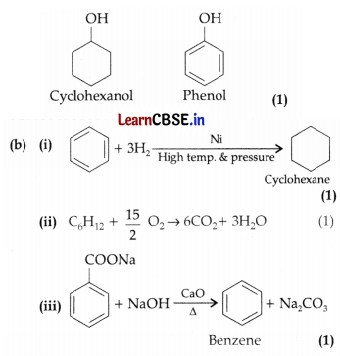Students must start practicing the questions from CBSE Sample Papers for Class 11 Chemistry with Solutions Set 1 are designed as per the revised syllabus.
CBSE Sample Papers for Class 11 Chemistry Set 1 with Solutions
Time Allowed : 3 hours
Maximum Marks: 70
General Instructions:
- There are 33 questions in this question paper with internal choice.
- Section – A consists of 16 multiple -choice questions carrying 1 mark each.
- Section – B consists of 5 short answer questions carrying 2 marks each. ,
- Section – C consists of 7 short answer questions carrying 3 marks each.
- Section – D consists of 2 case – based questions carrying 4 marks each.
- Section – E consists of 3 long answer questions carrying 5 marks each.
- All questions are compulsory.
- Use of log tables and calculators is not allowed.
Section-A
The following questions are multiple-choice questions with one correct answer. Each question carries 1 mark. There is no internal choice in this section.
Questions 1.
What will be the molarity of a solution, which contains 5.85 g of NaCl(s) per 500 mL?
(A) 4 mol L
-1
(B) 20 mol L
-1
(C) 0.2 mol L
-1
(D) 2 mol L
-1
Answer:
(C) 0.2 mol L
-1
Explanation:
Weight of NaCl (w) = 5. 85g
Volume of solution (V) = 500 mL
Molecular weight of NaCl = 58.5
Molarity = \(\frac{\mathrm{w} \times 1000}{\text { Molecular weight } \times \text { Volume in } \mathrm{mL}}
= [latex]\frac{5.85 \times 1000}{58.5 \times 500}\) = 0.2 mol L
-1
![]()
Questions 2.
The empirical formula and molecular mass of a compound are CH
2
0 and 180 g respectively. What will be the molecular formula of the compound?
(A) C
9
H
18
O
9
(B) CH
2
O
(C) C
6
H
12
O
6
(D) C
2
H
4
O
2
Answer:
(C) C
6
H
12
O
6
Explanation:
Empirical formula mass (CH
2
O)
= 12 + 2(1) + 16 = 30
Molecular mass = 180
Molecular mass 180
n = \(\frac{\text { Molecular mass }}{\text { Empirical formula mass }}\) = \(\frac{180}{30}\) = 6
∴ Molecular formula = n x empirical formula
= 6 x CH
2
O = C
6
H
12
O
6
Questions 3.
Which of the following conclusions could not be derived from Rutherford’s a-particle scattering experiment?
(A) Most of the space in the atom is empty.
(B) The radius of the atom is about 10 10 m while that of nucleus is 10 15 m.
(C) Electrons move in a circular path of fixed energy called orbits.
(D) Electrons and the nucleus are held together by electrostatic forces of attraction.
Answer:
(C) Electrons move in a circular path of fixed energy called orbits.
Explanation:
The concept of movement of electrons in circular path of fixed energy called orbits was given by Bohr.
Questions 4.
The number of radial nodes for 3p orbital is ………
(A) 3
(B) 4
(C) 2
(D) 1
Answer:
(D) 1
Explanation:
For 3p sub-shell, n = 3, 1 = 1
Number of radial nodes = n – l – l = 3 – l – l = l
![]()
Questions 5.
Consider the isoelectronic species, Na
+
, Mg
2+
, F
–
and O
2-
. The correct order of increasing length of their radii is …….
(A) F
–
< O- < Mg
2+
< Na
+
(B) Mg
2+
< Na
+
< F
–
< O
2-
(C) O
2-
< F
–
< Na
+
< Mg
2+
(D) O
2-
< F
–
< Mg
2+
< Na
+
Answer:
(B) Mg
2+
< Na
+
< F
–
< O
2-
Explanation:
The radii of cations and anions forming an isoelectronic series decreases with an increase in nuclear charge.
Questions 6.
Isostructural species are those which have the same shape and hybridization. Among the given species identify the isostructural pairs.
(A) [NF
3
and BF
3
]
(B) [BF
–
4
and NH
+
4
]
(C) [BCl
3
and BrCl
3
]
(D) [NH
2
and NO
–
3
]
Answer:
(B) [BF
–
4
and NH
+
4
]
Explanation:
(i) NF
3
is pyramidal whereas BF
3
is trigonal planar.
(ii) BF
4
–
and NH
4
+
are tetrahedral.
(iii) BCl
3
is triangular planar whereas BrCl
3
is pyramidal.
(iv) NH
3
is pyramidal whereas NO
3
is triangular planar.
Questions 7.
The types of hybrid orbitals of nitrogen in NO
+
2
, NO
–
3
and NH
4
+
respectively are expected to be:
(A) sp, sp
3
and sp
2
(B) sp, sp
2
, and sp
3
(C) sp
2
, sp and sp
3
(D) sp
2
, sp
3
and sp
Answer:
(B) sp, sp
2
, and sp
3
Explanation:
Number of orbitals involved in hybridization (H) = 1/2 [ V + M – C + A ]
where V = valence electrons of central atom
M = no. of monovalent atoms linked with central atom
C = charge of cation
A = charge of anion
NO
2
+
= 1/2 [ 5 + 0 – 1 + 0 ] = 2 or sp
NO
3
–
= 1/2 [ 5 + 0 – 0 + 1 ] = 3 or sp
2
NH
4
+
= 1/2 [ 5 + 4 – 1 + 0 ] = 4 or sp
3
Questions 8.
Choose the correct answer.
A thermodynamic state function is a quantity :
(A) used to determine heat changes.
(B) whose value is independent of path.
(C) used to determine pressure volume work.
(D) whose value depends on temperature only.
Answer:
(B) whose value is independent of path.
Explanation:
State function does not depend upon the path followed or is independent of the path followed.
![]()
Questions 9.
∆U° of combustion of methane is – X kj mol
-1
CH
4
(g) + 2O
2
(g) → CO
2
(g) + 2H
2
O(l)
The value of ∆H° is :
(A) = ∆U°
(B) > ∆U°
(C) < ∆U°
(D) = 0
Answer:
(C) < ∆U°
Explanation:
∆H° = ∆U° + ∆nRT
CH
4
(g) + 2O
2
(g) → CO
2
(g) + 2H
2
O(1)
∆n = n
p
– n
R
= l – 3 = -2
∆H = – ∆U – 2RT
∆H° < ∆U°
Questions 10. Among halogens, the correct order of amount of energy released in electron gain (electron gain enthalpy) is: (A) F > Cl > Br > I
(B) F < Cl < Br < I
(C) F < Cl > Br > I
(D) F < Cl < Br < I
Answer:
(C) F < Cl > Br > I
Explanation: In a group, electron gain enthalpy decreases while moving down but electron gain enthalpy of Cl is more negative than F. This happens due to addition of electron to 2 p orbital which results in greater repulsion than adding an electron to 3 p orbital.
Questions 11.
We know that the relationship between K
c/
and K
p
is
K
p
= K
c/
(RT)
∆n
What would be the valu e of ∆n for the reaction:
NH
4
Cl(s)⇄ NH
3
(g) + HCl(g)
(A) 1
(B) 0.5
(C) 1.5
(D) 2
Answer:
(B) 0.5
Explanation:
∆n = (Number of moles of gaseous products) – (Number of moles of gaseous reactants) = 2 – 0 = 2
Questions 12.
For the reaction H
2
(g) + I
2
(g), 2HI(g), the standard free energy is ∆G
θ
. The equilibrium constant (K) would be:
(A) K = 0
(B) K > 1
(C) K = 1
(D) K < 1 Answer: (B) K > 1
Explanation:
∆G° = – RT In K. ∆G° > 0 means ∆G° is positive. This is possible only if InK is negative, i.e., K < 1.
Questions 13.
Given below are two statements labelled as Assertion (A) and Reason (R).
Assertion (A): Simple distillation can help in separating a mixture of propan-l-ol (boiling point 97°C) and propanone (boiling point 56°C).
Reason (R): Liquids with a difference of more than 20°C in their boiling points can be separated by simple distillation. Select the most appropriate answer from the options given below:
(A) Both A and R are true and R is the correct explanation of A.
(B) Both A and R are true but R is not the correct explanation of A.
(C) A is true but R is false.
(D) A is false but R is true.
Answer:
(A) Both A and R are true and R is the correct explanation of A.
Questions 14.
Assertion (A): Generally, ionization enthalpy increases from left to right in a period.
Reason (R): When successive electrons are added to the orbitals in the same principal quantum level, the shielding effect of inner core of electrons does not increase very much to compensate for the increased attraction of the electron to the nucleus. Select the most appropriate answer from the options given below:
(A) Both A and R are true and R is the correct explanation of A.
(B) Both A and R are true but R is not the correct explanation of A.
(C) A is true but R is false.
(D) A is false but R is true.
Answer:
(A) Both A and R are true and R is the correct explanation of A.
Explanation:
Assertion and reason both are correct statements and reason is correct explanation of ‘ assertion
![]()
Questions 15.
Assertion (A): The compound cyclooctane has the following structural formula: It is cyclic and has conjugated 8π -electron system but it is not an aromatic compound.
Reason (R): (4n + 2) n electrons rule does not hold good and ring is not planar.
Select the most appropriate answer from the options given below:
(A) Both A and R are true and R is the correct explanation of A.
(B) Both A and R are true but R is not the correct explanation of A.
(C) A is true but R is false.
(D) A is false but R is true.
Answer:
(A) Both A and R are true and R is the correct explanation of A.
Questions 16.
Assertion (A): Toluene on Friedal-Crafts methylation gives o- and p-xylene.
Reason (R): CH3-group bonded to benzene ring increases electron density at o- and p- position. Select the most appropriate answer from the options given below:
(A) Both A and R are true and R is the correct explanation of A.
(B) Both A and R are true but R is not the correct explanation of A.
(C) A is true but R is false.
(D) A is false but R is true.
Answer:
(A) Both A and R are true and R is the correct explanation of A.
Section-B
This section contains 5 questions with internal choice in one question. The following questions are very short answer type and carry 2 marks each.
Questions 17.
(a) Give the balanced chemical equation for combustion of Methane gas.
(b) Calculate the amount of water (g) produced by the combustion of 16 g of methane.
Answer:
The balanced equation for combustion of methane is-

(b) 1 mole of CH
4(g)
gives 2 mol of H
2
O(g)
2 moles of water (H
2
O)
= 2 x ( 2 + 16 ) = 2 × 18 = 36g
1 mole H
2
O = 18g H
2
O ⇒ \(\frac{18 \mathrm{~g} \mathrm{H}_2 \mathrm{O}}{1 \mathrm{~mol} \mathrm{H}_2 \mathrm{O}}\)
∴ Amount of water produced by the combustion of 16g of methane = 2 mol H
2
O x \(\frac{18 \mathrm{~g} \mathrm{H}_2 \mathrm{O}}{1 \mathrm{~mol} \mathrm{H}_2 \mathrm{O}}\)
= 2 x 18g H
2
O = 36g H
2
O
Questions 18.
Mention the physical significance of Ψ and Ψ
2
.
Answer:
Physical significance of Ψ:
All the information about the electron in an atom is stored in its orbital wave function y and quantum mechanics makes it possible to extract this information out of Ψ. (1)
Physical significance of Ψ
2
:
From the value of |Ψ|
2
at different points with in an atom, it is possible to predict the region around the nucleus where electron will most probably be found. (1)
Questions 19.
(a) Which has maximum bond angle?
CH
4
, BeCl
2
, NH
2
.
(b) Arrange the above compounds in decreasing order of bond angle.
Answer:
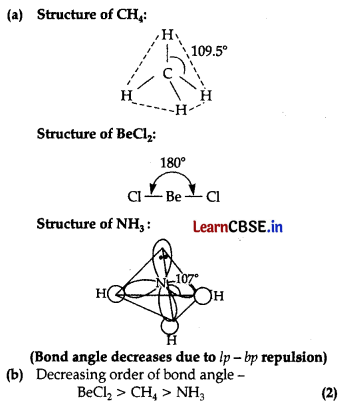
Questions 20.
Give the IUPAC name/structure of:
(i) (CH
3
)
2
(C
2
H
5
)C-(CH
2
)
3
-C(CH
3
)
3
(ii) Ortho-chloro anisole
OR
Write IUPAC names of the following:
![]()
Answer:
2,2,6,6 – tetramethyl octane
(CH
3
)
2
(C
2
H
5
)C -(CH
2
)
3
– C(CH
3
)
3
Or
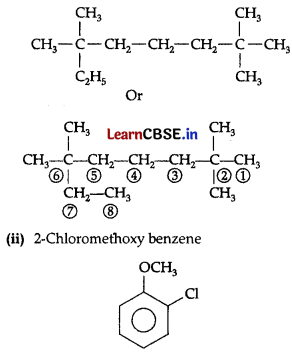
Or
(i) 1 – chloroethene
(ii) 1 – methylcyclobutane
Questions 21.
(a) Define buffer solution.
(b) Give one example each of acidic and basic buffer.
Answer:
(a) The solution which resists change in pH on dilution or with the addition of small amounts of acid or alkali is called buffer solution. (1)
(b) Example of acidic buffer-
CH
3
COOH + CH
3
COONa (pH = 4.75) (1/2)
Example of basic buffer-
NH
4
OH + NH
4
C1 (pH = 9.25) (1/2)
Section-C
This section contains 7 questions with internal choice in one question. The following questions are short answer type and carry 3 marks each. (No internal choice given in Board SQP)
Questions 22.
Calculate:
(i) Mass in gram of 5.8 mol NzO
(ii) Number of moles in 8.0 g of O
2
(iii) Molar mass if 11.2 L at STP weigh 8.5 g
Answer:
(i) Molecular mass of N
2
O = 2(14) + 16 = 44
Mass = Molecular mass × No. of moles
= 44 × 5.8
(ii) Number of moles of
Mass of 02 8.0
O
2
= \(\frac{\text { Mass of } \mathrm{O}_2}{\text { Molecular mass of } \mathrm{O}_2}\) = \(\frac{8.0}{32}\) = 0.25 mol
(iii) ∵ 11.2 L at STP weigh = 8.5 g
∴ 22.4 L at STP will weigh
= \(\frac{8.5}{11.2}\) × 22.4 = 17g mol
-1
![]()
Questions 23.
Ethyl acetate is formed by the reaction between ethanol and acetic acid and the equilibrium is represented as:
CH
3
COOH(l) + C
2
H
5
OH(l) CH
3
COOC
2
H
5
(l) + H
2
O(l)
(i) Write the concentration ratio (reaction quotient) Qc, for this reaction (Note : water is not in excess and is not a solvent in this reaction).
(ii) At 293 K, if one starts with 1.00 ml of acetic acid and 0.18 mol of ethanol, there is 0.171 mol of ethyl acetate in the final equilibrium mixture. Calculate the equilibrium constant.
(iii) Starting with 0.5 mol of ethanol and 1.0 mol of acetic acid and maintaining it at 293 K, 0.214 mol of ethyl acetate is found after sometime. Has equilibrium been reached ?
Answer:
(i) The given reaction is:
CH
3
COOH(l) + C
2
H
5
OH(l) ⇌ CH
3
COOC
2
H
5
(l) + H
2
O(l)
H
2
O is not in excess and is not a solvent.
(i) Q
c
= \(\frac{\left[\mathrm{CH}_3 \mathrm{COOC}_2 \mathrm{H}_5(l)\right] \times\left[\mathrm{H}_2 \mathrm{O}(l)\right]}{\left[\mathrm{CH}_3 \mathrm{COOH}(l)\right] \times\left[\mathrm{C}_2 \mathrm{H}_5 \mathrm{OH}(l)\right]}\)
(ii) = [CH
3
COOC
2
H
5
(l)] = 1. 00 mol
[C
2
H
5
OH(l)] = 0.18 mol
[CH
3
COOC
2
H
5
(l)] = 0.171 mol
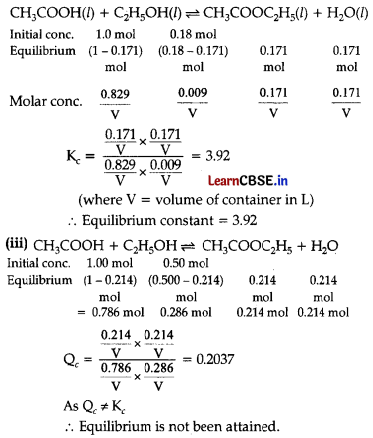
Questions 24.
What is the (a) formula of compound (b) Nature of bond formed between element ‘X’ atomic number 31 and
element’/ atomic number 8? Draw the Lewis dot structure. What is the formula of compound?
Answer:
31
X = 2,8,18,3(Ga)
8
y = 2,6 (O)
∵ There is a very high electronegative difference in both these elements. So, these elements form an ionic bond.
Lewis dot structure-
Img-8
Questions 25.
The enthalpy of combustion of methane, graphite and dihydrogen at 298K are – 890.3 kJ mol
-1
, -393.5 kJ mol
-1
and -285.8 kJ mol
-1
respectively. Calculate enthalpy of formation of methane gas.
Answer:
Given that,
-
CH
4
(g) + 20
2
(g) → CO
2
(g) + 2H
2
O(g);
∆ c H° = -890.3 kJ mol -1 - C(s) + O 2 (g) → CO 2 (g); ∆ c H°= -393.5 kJ mol -1
- H 2 (g) + 1/2 O 2 (g) → H 2 O(g); ∆ c H° = -285.8 kJ mol -1
We have to calculate AfH° of the equation:
C(s) + 2H
2
(g) → CH
2
(g); ∆
f
H° = ?
Applying inspection method,
– eq. (i) + eq. (ii) + 2 x eq. (iii)
-CH
4
(g) – 2O
2
(g) + C(s) + O
2
(g) + 2H
2
(g) + O
2
(g) → – CO
2
(g) – 2H
2
O(g) + CO
2
(g)(1)
Or
C(s) + 2H
2
(g) → CH
4
(g)
∴ ∆H
θ
= – (- 890.3) + ( – 393.5) + 2 × (- 285.8)
= 890.3 – 393.5 – 571.6
= 890.3 – 965.1 = – 74.8 kJ mo1
-1
![]()
Questions 26.
Differentiate between the following (with examples):
(i) Open and closed system
(ii) Adiabatic and Isothermal process
(iii) State function and path function
Answer:
(i)
| Open System | Closed System |
| It can exchange matter as well as energy with its surroundings. e.g., Reaction mixture in open beaker. |
It does not exchange matter with its
surroundings but can exchange energy in the form of heat, e.g., Hot water in a closed container. |
(ii)
| Adiabatic Process | Isothermal Process |
| In this process, no heat can flow in or out of the system, i.e., dq = 0 | In this process, temperature remains constant, i.e., dl = 0 |
(iii)
| State Function | Path Function |
| The variables which depend upon the initial and final states of a system are called state functions, e.g., Internal energy, pressure, volume, enthalpy, etc. | The variables which depend upon the path followed are called path functions, e.g., Heat, work, etc. |
Questions 27.
In sulphur estimation, 0.157 g of an organic compound gave 0.4813g of BaSO
4
. What is the % of sulphur in the given organic compound?
Answer:
Mass of organic compound = 0.157 g
Mass of BaSO
4
= 0.4813 g
Percentage of Sulphur
= \(\frac{32}{233}\) = \(\frac{\text { Massof } \mathrm{BaSO}_4}{\text { Mass of organiccompound }}\) × 100
= \(\frac{32}{233}\) × \(\frac{0.4813}{0.197}\) × 100 = 42. 10%
Questions 28.
Explain briefly carcinogenicity and toxicity of aromatic hydrocarbon.
Answer:
Benzene and polynuclear hydrocarbons containing more than two benzene rings fused together are toxic and said to possess cancer producing property. Such polynuclear hydrocarbons are formed due to incomplete combustion of organic material like tobacco, coal and petroleum. They damage DNA and cause cancer. Some of the carcinogenic polynuclear hydrocarbons are 1, 2-Benzanthracene, 3-methyl- cholanthrene, 1, 2 Benzpyrene, 1, 21, 2:5, 6, 5, 6 – Dichloro anthracene and 9, 10 – Dimethyl 1, 2, – Benzanthracene.
Section-D
The following questions are case – based questions. Each question has an internal choice and carries 4 ( 1 + 1 + 2 ) marks each. Read the passage carefully and answer the questions that follow.
Questions 29.
Read the following passage and answer the following questions:
The energy needed to remove the neutral atom’s most loosely bonded electron is known as the first ionisation enthalpy (IE1). The second ionisation enthalpy (IE2) is the energy needed to remove the second electron from the resultant cation, and so on. The energy needed to remove an s-electron from the same shell would require more ionisation enthalpy than it would to remove a p-electron, which in turn would take more energy than it would to remove a d-electron, and so on. Due to a rise in the number of inner electrons that balance off the increase in nuclear charge, there is an increase in the shielding effect on the outermost electron, and the removal of the outermost electron takes less energy down a group.
(a) Which element in periodic table has highest ionization energy (IE)?
(b) Although B is larger than Be, it has a lower first ionisation energy than Be. Why?
OR
How size of an atom affects its ionization enthalpy?
(c) How does screening effect work? In what ways does it affect the ionisation enthalpy?
Answer:
(a) Helium has the highest ionization enthalpy. (1)
(b) Electronic configuration of Be(4) = 2,2 = Is2, and 2s2 is the answer.
Electronic setup of B(5) = 2, 3 = Is2, 2s2, and 2p’ Compared to B, Be’s 2s orbital is fully filled, hence more energy is needed to remove an electron from there. Therefore, boron’s initial I.E. is lower than Be. (1)
OR
The ionisation enthalpy depends upon the distance between the electron and the nucleus, i.e., size of the atom. It decreases with increase in atomic size. (1)
(c) Screening Effect:
The outermost electrons are protected from the nucleus’s attractive pull by the core electrons in the inner shells. Screening effect is the name given to this kind of impact. (1) The effective nuclear charge decreases with an increase in the screening effect. As a result, the valence shell electrons’ force of attraction towards the nucleus reduces, which lowers the ionisation enthalpy.
![]()
Questions 30.
Read the Passage and answer the following Questions:
Put a strip of metallic zinc in a copper nitrate aqueous solution for roughly an hour. The strip may start to acquire a reddish metallic copper coating, and the solution’s original blue colour may start to fade. When the blue colour of the solution caused by Cu2+ has vanished, it is simple to determine that Zn2+ ions are among the products. Making the solution alkaline with ammonia will cause the appearance of white zinc sulphide, or ZnS, if hydrogen sulphide gas is passed through the colourless solution containing Zn2+ ions.
(a) Write the chemical reaction taking place between metallic zinc and copper nitrate aqueous solution. A I
(b) Define standard electrode potential.
OR
Out of Zn and Cu vessel, one will be more suitable to store 1M HC1?
Given, E
θ
Zn
2+
/Zn
= – 0.76 V
E
θ
Zn
2+
/Cu
= + 0.34 V
(c) What is metal activity series? Does the series have another name? What is the basis of the series and which
type of cell is used to prepare this?
Answer:
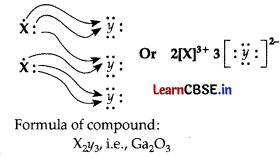
(b) The standard electrode potential is the potential of an electrode where the concentration of each species participating in the electrode reaction is unity (if any gas is involved, its pressure is considered as 1 atmosphere), and where the temperature is kept at 298 K (1)
OR
As we know that the metals having negative value of standard reduction potential (E
θ
) are highly reactive and displace hydrogen from acids. So, out of Zn and Cu vessel. Zn has negative value of E
θ
i.e., – 0.76 V, hence it displaces hydrogen from 1 M HCl and Cu has positive value of E
θ
i.e., + 0.34V, hence it cannot displace hydrogen from 1 M HC1. Thus, it is concluded that Cu vessel will be more suitable to store 1 M HC1.
(c) The list of elements in the activity series is arranged in decreasing order of reactivity. This list of metal elements is known as metal activity series. The electrodes (metals and nonmetals)
in contact with the ions of the elements are organised according to the values of their standard reduction potentials or standard oxidation potentials, and thus, also known as electrochemical, electromotive, or activity series of the elements. The Galvanic cell is used for this purpose.
Section-E
The following questions are long answer type and carry 5 marks each. All questions have an internal choice.
Questions 31.
Attempt any five of the following:
(a) Write the electronic configuration of the following ions:
(i) He
+
(ii) Mg
2+
(b) What are the atomic numbers of elements whose outermost electrons are represented by:
(i) 3s
2
(ii) 2p
5
(c) Which atoms are indicated by the following configurations?
(i) [He] 2s
2
(ii) [Ne] 3s
2
3p
5
(d) Write short note on Aufbau principle.
(e) What are the values of all the four quantum numbers for the nineteenth electron of copper?
(f) Which quantum number is not obtained from solution of Schrodinger wave equation?
(g) How many radial and angular nodes are present in 2
p
orbital?
Answer:
(a) (i) He
+
: Number of electrons = 2 – 1 = 1 Electronic configuration = 1s
1
(ii) Mg
2+
: Number of electrons = 12 – 2 = 10 Electronic configuration = 2,8 = 1s2,2s2,2p6
(b) (i) 3s
2
, Atomic number of element = 12
(ii) For 2p
5
, Atomic number of element = 9 (1)
| Electronic | Atomic No. | Atom Configuration |
| (i) [He] 2s 2 | 4 | Be |
| (ii) [Ne] 3s 2 3p 5 | 17 | Cl |
(d) Aufbau principle:
According to this principle, “In the ground state of the atoms, the sub-shells are filled in order of their increasing energies. In case, two or more sub-shell have same energy then electron can be filled in those sub-shell, which has least ‘n’ value.
(e)
29
Cu = 2, 8, 18, 1 = 1s
2
, 2s
2
2p
6
, 3s
2
3p
6
3d
10
, 4s
1
19th electron of copper lies in 4s orbital.
Therefore, n = 4, 1 = 0, m = 0, s = +1/2
(f) Spin quantum number is not obtained from solution of Schrodinger wave equation. (1)
(g) Radial nodes = n – 1 -1
Angular nodes = n – 1
Here in case of 2p, the value of n = 2
Therefore, 2p orbital contains-
Radial nodes = 0
Angular nodes = 1
![]()
Questions 32.
(i) Define Isomerism. Explain position isomerism with examples.
(ii) Write structural formulae for compounds named as
(a) 1 – Bromoheptane
(b) 5 – Bromoheptanoic acid
OR
(a) Define homologous series. Write the general formula of alkane, alkene and alkynes.
(b) Define functional groups. Write the general formula of carboxylic acids acid chlorides.
Answer:
Two or more compounds having the same molecular formula but different physical and chemical properties are called isomers and this phenomenon is called isomerism.
Position Isomerism :
Compounds which have the same structure of carbon chain but differ in position of double or triple bonds or functional group are called position isomers and this phenomenon is called position isomerism, e. g., CH
3
– CH
3
– CH = CH
2
and CH
3
– CH = CH – CH
3
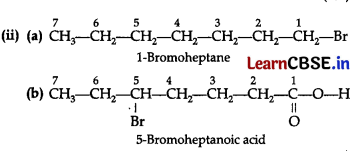
OR
(a) Homologous Series:
It is defined as group of similar organic compounds which contains the similar functional groups and the two adjacent members of the series differ by a -CH2 group. For example, alkanes, alkenes, alkynes, etc.
Alkanes C
n
H
2n+2
Alkenes C
n
H
2n
Alkynes C
n
H
2n-2
(3)
(b) Functional Groups:
It is an atom or group of atoms bonded together in a unique manner which is usually the site of chemical reactivity in an organic molecule, e.g. CH
3
OH
General formula of carboxylic acids: C
n
H
2n+1
+COOH
General formula of acid chlorides: RCOC1 (2)
Questions 33.
Give mechanism of addition of HBr to Propene.
OR
(a) (i) Arrange the following set of compounds in the order of their decreasing relative reactivity with an electrophile.

(ii) Give one important structural difference between cyclohexanol and phenol.
(b) Complete the following reactions:
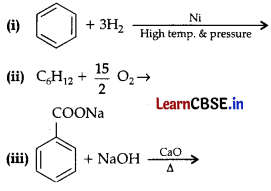
Answer:
Addition of HBr to propene (unsymmetrical alkene) follows Markovnikov’s rule according to which the negative part of the addendum gets attached to that C atom which possesses lesser number of hydrogen atoms.
Answer:
Addition of HBr to propene (unsymmetrical alkene) follows Markovnikov’s rule according to which the negative part of the addendum gets attached to that C atom which possesses lesser number of hydrogen atoms.

Mechanism:
Hydrogen bromide provides an electrophile, H+, which attacks the double bond to form carbocation as:
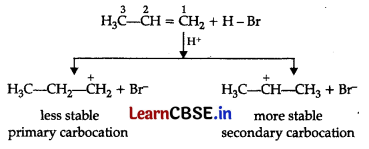
Secondary carbocations are more stable than primary carbocations. Therefore, the former predominates as it will form at a faster rate. Thus, in the next step, Br“ attacks the carbocation to form 2-bromopropane as the major product.

Addition of HBr to unsymmetrical alkenes like propene in the presence of light or peroxide takes
place contrary to the Markovnikov’s rule. This so happens only with HBr but not with HC1 and HI. This addition of HBr to propene in the presence of benzoyl peroxide follows anti-Markovnikov’s rule or peroxide effect or Kharash effect.
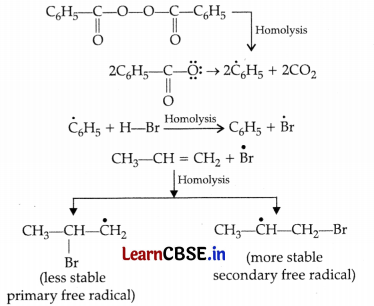
Secondary free radicals are more stable than primary radicals. Therefore, the former predominates since it forms at a faster rate. Thus, 1-bromopropane is obtained as the major product.
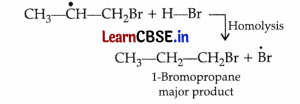
The overall reactivity of these three compounds towards electrophiles decreases in the following order:
Anisole > Chlorobenzene > Nitrobenzene
(ii) In phenol, benzene ring has alternate single and double bonds while cyclohexanol is alicyclic compound.
In phenol, benzene ring has alternate single and double bonds while cyclohexanol is alicyclic compound.
